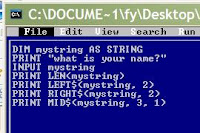
- Fun-roc who claim to own it all
- Magda Vacariu who acknowledges the Arty Factory website but has copied all the content into her own blog for art students - why not just link to it?
I teach "DigiTech" to secondary students in Christchurch, New Zealand. I am passionate about teaching and learning using ICT and I want to experiment with a blog as both a personal tool and a teaching tool.

Use the wikipedia page on animation to find the following
Use the wikipedia page on computer animation to find the meaning of important terms
Use your computer's Start > All Programs to identify any software that can be used to make animations. Make a list of them and choose one to experiment with. An easy choice would be UnFREEz which you used in Year 9 - you made a series of frames in Paint and saved them as file type: gif, then put them in to UnFREEz. Other options are MovieMaker and Blender.
Plan and start to make a simple animation (no more than 10 frames) about one of these topics:
When you have finished your first project to the best of your ability, do these tasks.



A common technique used with strings is to use a FOR loop to cycle through the letters in the string:
FOR i = 1 to LEN(mystring)
PRINT MID$(mystring, i, 1)
NEXT i
What are the equivalent techniques for these functions in Visual Basic? See Program Example 14 String Handling 1.

In your second project this year, you need to consider how to show clearly which of the following topics each page relates to: Skills (AS 90368), Project (AS 90349) or Community Responsibilities (AS 90773). Ways of doing this include
Extra for Experts:

If you did 1, 2, 3 or another sensible thing, you should print what you did.
If you did 4, you should hand-write notes on your print-out about how long each thing took and what changes you needed to make to your timeline.


A third place where the word evaluation appears is in the Code of Practice sheets. In this case, it is asking you to provide evidence of how you have followed the rules for that Code of Practice.

Before asking for help on this one, write some of your own questions for investigation.
When you are exploring your proposed solution, you should be looking at these sort of details as they will help to justify why your solution is "fit for purpose".

Even a modern-day Swiss Army Knife can't stop you from leaving it behind!


And some more philosophical ones:
And some more websites:
Next steps:
A SPECIFICATION is measurable and describes what the solution will be, or look like, or behave, or do. Each key factor should be investigated and researched to develop a specification.
When you have printed your refined brief, you could hand-write on the page where each specification came from.
Here is an example:
My husband and I are planning a 90th birthday party for my father-in-law. As part of the event, we will have a slideshow of photos of Les's life. Key factors for the slideshow include:
Key factor research tells us that "three minutes is a long stretch for time-based media. The infomercials you see on late-night TV are often three minutes long, and they feel repetitive and endless" (quoted fromMediapedia by Kit Laybourne).
This suggests an attribute: the presentation should be short.
This then becomes a specification: the presentation should be three minutes long.

You are Alex. Your client/main stakeholder is Sam. Your other stakeholders are Sam's friends. Consultation is about finding out how to make Sam want to be with you!
Areas that seem important to me are
Sources of information include:
Your conceptual design might be shown to the client by any of these methods that suit your issue:

To record this information you could

Here is an example - but you can do better!
It is hard to show the resources on the same sheet of paper. You may wish to copy your final task list onto another worksheet and show the resources needed on a separate page.
Remember that for this project you do not have to create the solution, just design it.
Extra for experts: Waht about CSS? XHTML? Standards compliance?
File name: My Issues
Keywords: Issues, Cashmere